Disclosure: Meeple Mountain received a free copy of this product in exchange for an honest, unbiased review. This review is not intended to be an endorsement.
Expeditions, designed by Jamey Stegmaier of Stonemaier Games, is a game set a few years after his game Scythe takes place. In Expeditions, a meteor has crashed into Earth, releasing an ancient corruption into the lands. Players take on the role of explorers who, along with their animal companion, make their way above the northern borders of the Scythe map to rid the world of corruption and seek Glory and fame.

If you’ve played Scythe before, some of the components in Expeditions will look familiar—and in both games, the goal is still to be the player with the most points. How you earn and score those points, however, is very different, making Expeditions a game that easily stands on its own.
Let’s get it to the table so I can show you what I mean.
Set Up
Instead of a formal board, Expeditions is played through a honeycomb of 20 hexes that connect, at most, along three edges. These hexes are divided into three zones, the Southern, Central, and the Northern lands. The Southern hexes are laid out randomly, face up, with three of the six tiles placed adjacent to the Basecamp board.
Shuffle the Central and Northern hexes, then lay them out, face down, with the Central tiles in the center and the Northern tiles at the top. Place a Map token on each of these.
Shuffle the big deck of cards and randomly place five cards in the gaps of the honeycombed hex configuration.
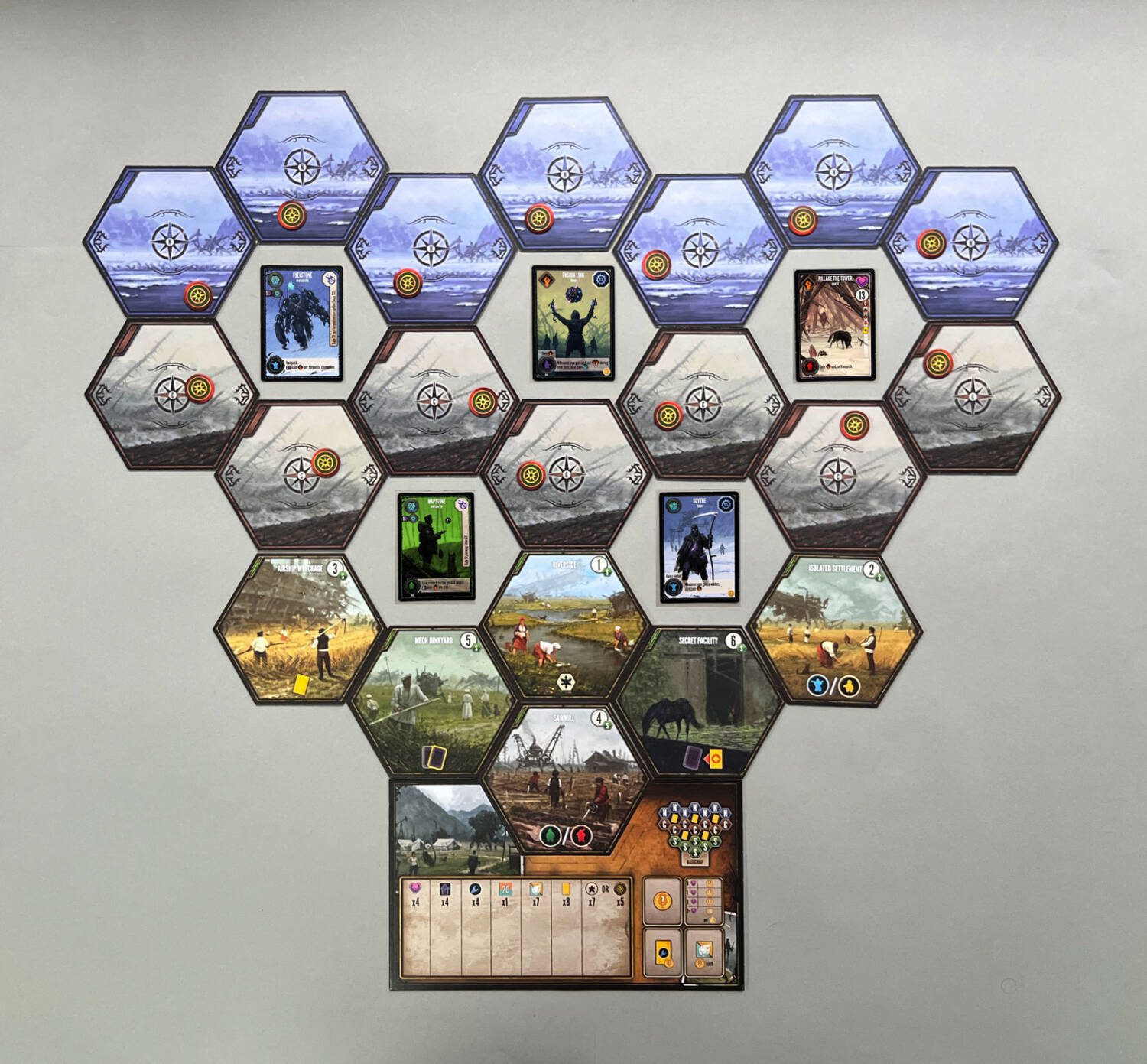
Players take a random player board and a random character card and the accompanying companion card.

Place four Glory stars and a cube in their chosen color on their board.
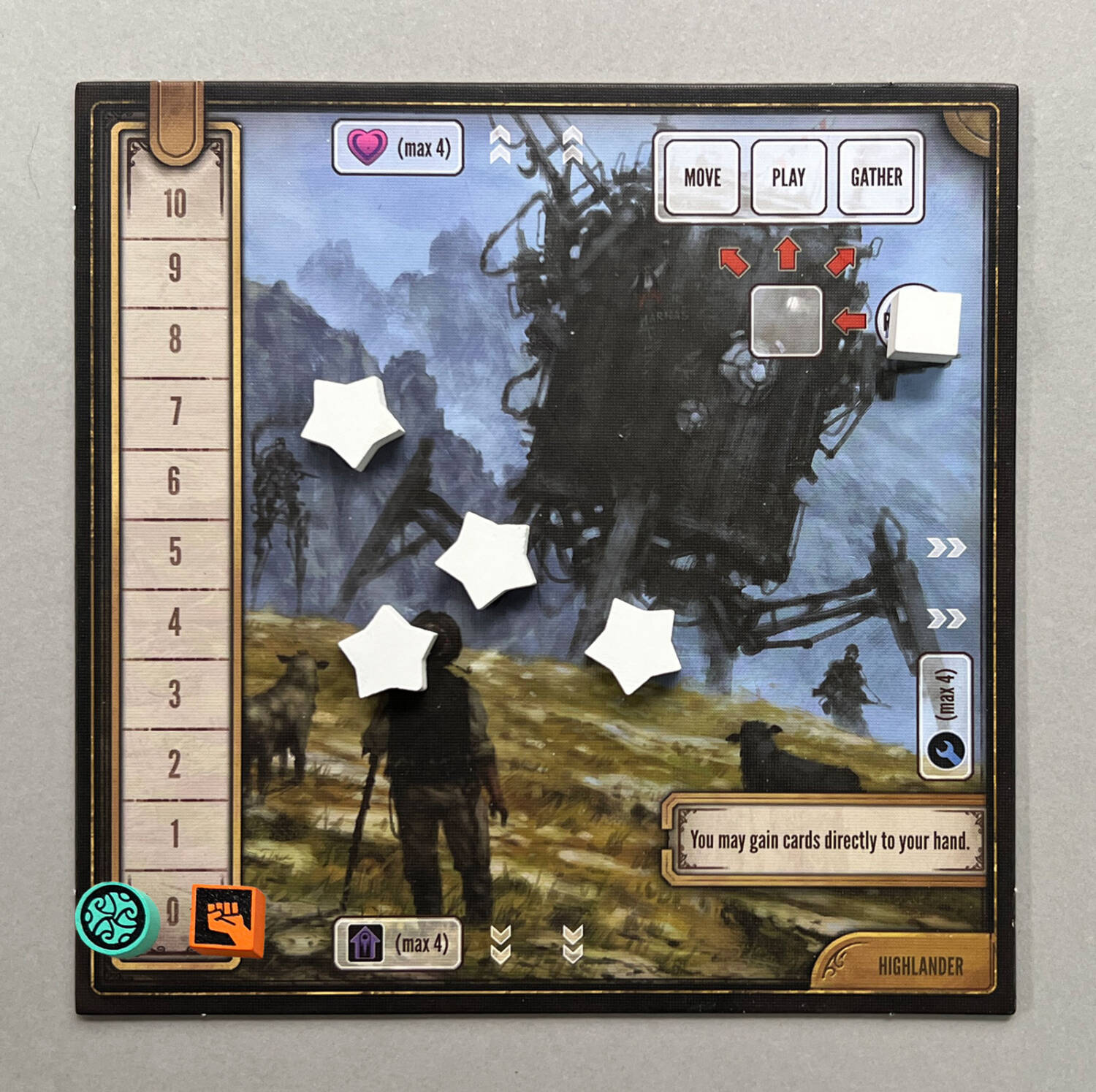
Players take a Mech of their choosing and set it in a plastic base matching the color of their stars and cube.

Randomly determine the starting player and you’re ready to play.
Playing the Game
Play, Move, Gather
On your first turn you’ll be able to take all three of the standard actions: Move (to another tile up to three hexes away), Play (a card from your hand into your Active area), and Gather (take the resource shown on the hex). You always get to choose the order in which to take these actions.
The Southern hexes allow you to gather more cards or workers, both of which you’ll need to build up your engine. When you play a card from your hand to your active area, you’ll automatically get one of two resources, Guile [turquoise] and Power [red]. These are shown in the upper left corner of each card. As well, each card also has an action listed at its bottom. To take that action, you’ll need to place a worker of the matching color onto the card.
After that first turn, players will need to move their cube to cover one of those three actions. So, instead of being able to Move, Play, and Gather, you’ll have to choose two of those actions. On the following turn, you’ll need to move your cube again to cover up a different ability and take those two actions. This creates some tough decision spaces throughout the game.
Expeditions is an open-card game. The cards in your hand are actually placed face up, to the left of your player board. When you then play a card, you move it to the right side of your board, with each new card being placed on the immediate right of the last card played. When you gather a new card, you always place it into your Active area, to the right of all your played cards. However, since you gathered this card instead of playing it, you aren’t able to place a worker on it to use its bottom action—yet.
Eventually, you’ll run out of cards to play, or reach a point where, strategically, you want to take all three actions in a single turn. Then it’s time to Refresh. You’ll move all your cards back to the left side of the board and return your workers from the cards to your player board. On your next turn, you’ll be able to play any card from your hand and take all three actions.
Quests, Items, Meteorites
Other than your character and companion cards, there are three types of cards: Quests, Items, and Meteorites.
Quests will have a number on the upper right side of the card showing which hex you need to be on to Solve it. Below that number are 1-3 Guile or Power symbols. When your Mech is on the same numbered hex, you’ll need to pay the indicated amount of Guile or Power to Solve the Quest.

Once you’ve Solved a Quest, you’ll take the reward listed below the required Guile or Power. Then you’ll tuck the Quest card under the top of the board.
Item and Meteorite cards can be Upgraded or Melded, respectively, once a hex with the respective action symbol has been uncovered—and the Corruption that covers it has been removed. (I’ll get to that in just a moment.) You’ll tuck Upgraded Item cards under the right side of the board where their powers become available on every turn without the need of a worker being placed on them.
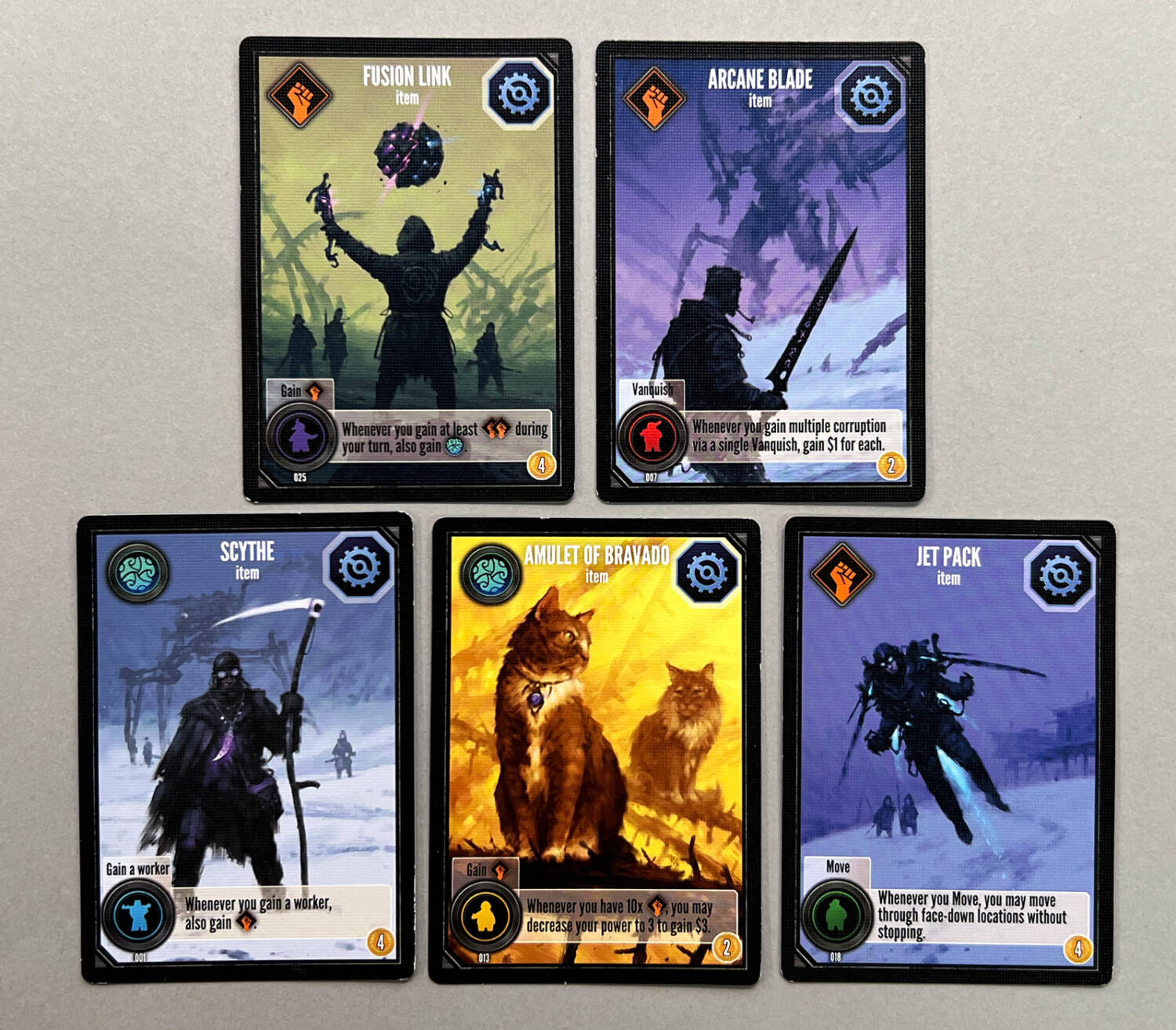
Melded Meteorites are tucked sideways under the bottom of the board where each melded bonus is triggered whenever a new Meteorite is Melded.
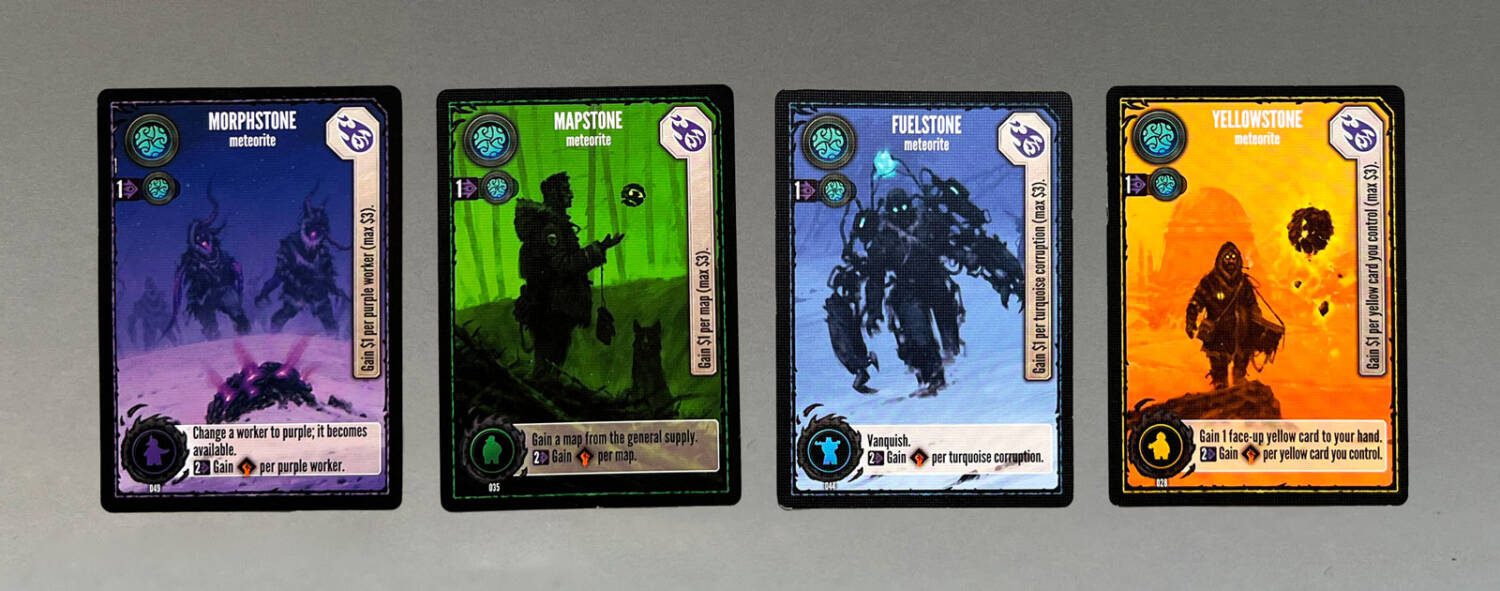
Exploration, Corruption
Once you move your Mech out of the Southern zone, you must stop at the first upside-down tile it encounters. You’ll start by claiming the Map token on top of the tile, then turn the tile over. Central tiles will each have a Gather icon at the bottom left, next to a slash and another Gather icon with the number 5 nearby. Northern tiles will have multiple actions available, but the one to the right will commonly have an 8 beside it.
These numbers refer to the minimum number of Corruption tiles that need to be drawn blind from the Bag o’ Corruption and placed atop the action. Corruption tiles come in numbers 3-5 and in both the turquoise of Guile and the red of Power. In either case, you’ll draw tiles until you have met or exceeded the number indicated.
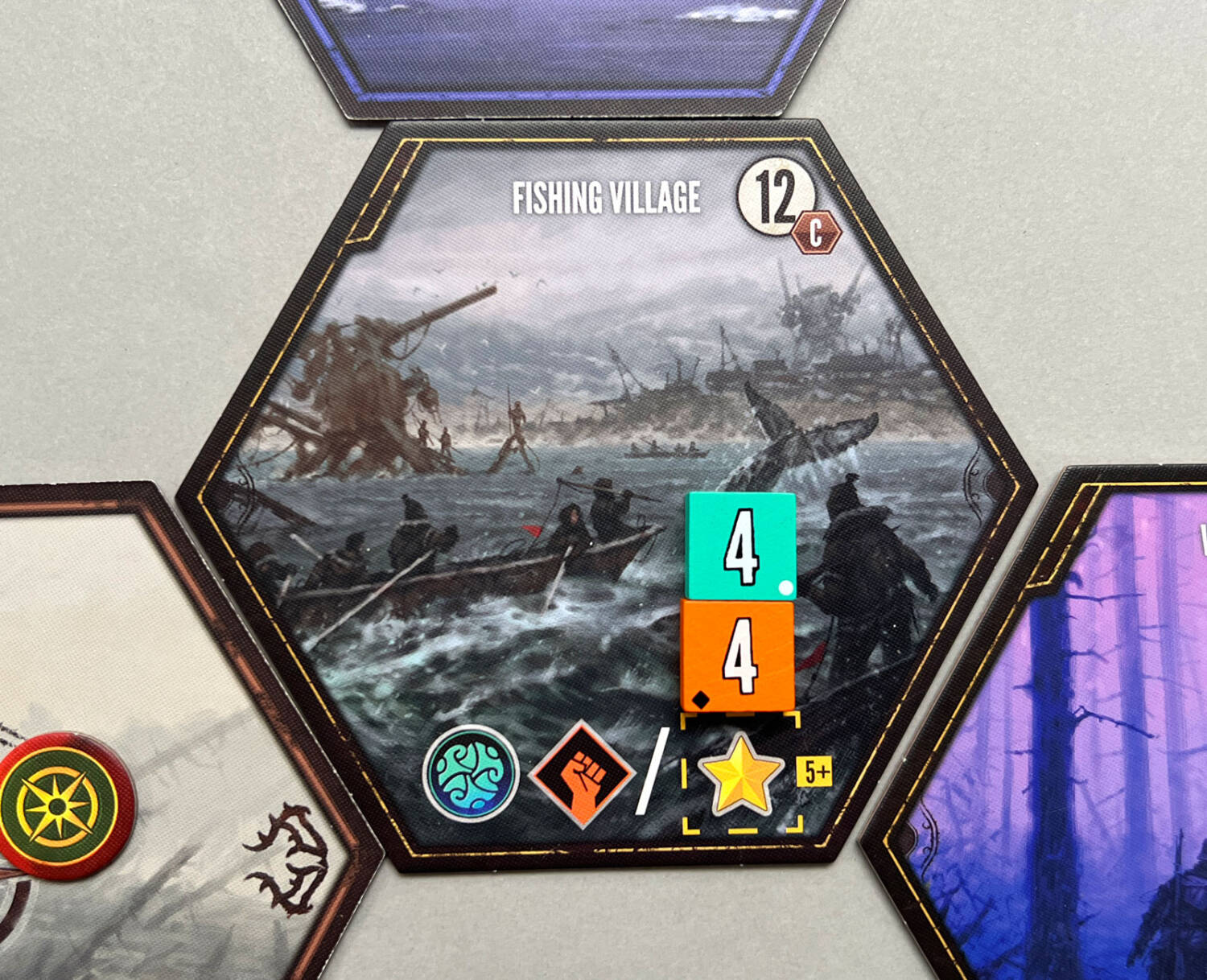
To get rid of the corruption, you’ll first need to play a card that allows you to Vanquish the corruption. Only then can you spend the Guile or Power on the matching corruption tile to claim them for your own.
Scoring
Scoring in Expeditions differs from the way scoring is handled in Scythe. In Scythe, once you meet a requirement (Win a Combat, Deploy all four Mechs, etc.) you automatically place a Glory star on the board. In Expeditions, it’s not enough to have met a Glory star condition; you must go to a hex with a Boast action—that players have cleared of corruption—then take a gather action to place a Glory star in the appropriate category on the Basecamp board.
There seven ways to earn a Glory star: Solve four Quests; Meld four Meteorites; Upgrade four Items; Vanquish seven corruption; Vanquish the lone 20 corruption tile; have eight cards in your hand and/or active area; have seven workers or five Map tokens.
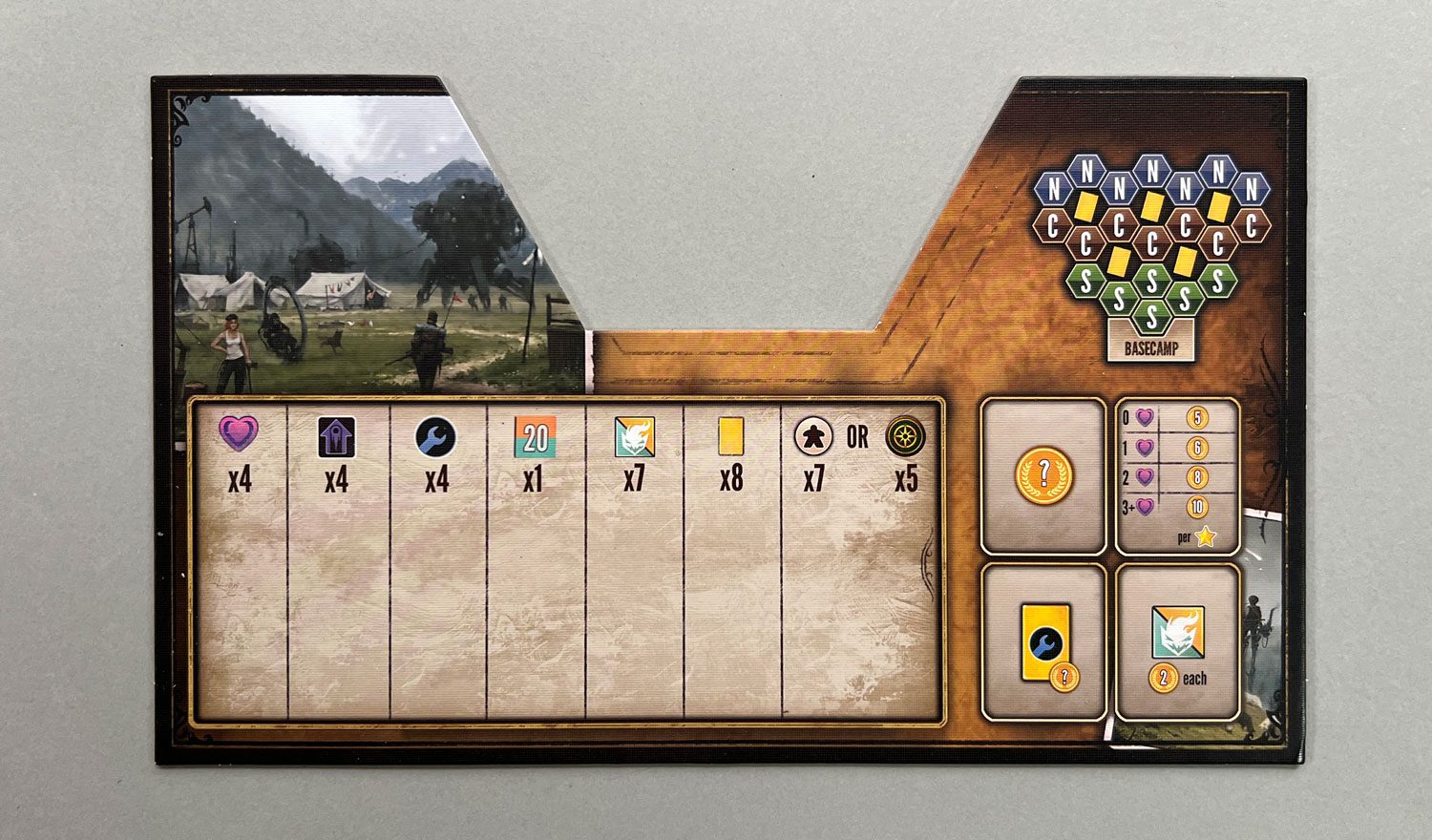
Glory stars are only part of the scoring, however. The value of each Glory star depends on how many Quests you have Solved—up to ten points for three+ corruption tiles. Resolved corruption tiles get placed on your board and will score you two points each at the end of the game. There are also point values on your upgraded Item cards. Some cards also earn you coins, which convert to points at a 1:1 ratio.
The first person to place their fourth star on the Basecamp board triggers the end of the game. Each player then takes one last turn (including the player who placed the fourth star) before tallying points and declaring a winner.
Thoughts
Expeditions calls itself A Sequel to Scythe. This, I think, sets some unfortunate expectations that the game does not deserve. For those who like Scythe and are looking for another game like it, this is not the game. For those who do not like Scythe, and dismiss Expeditions because of its “Sequel to Scythe” subtitle, they do the game a disservice.
Where Scythe is largely a multiplayer solitaire game of ruthless efficiency…

…Expeditions is a card-driven game of exploration where the movements and actions of one player can affect the plans of another player. (For instance, only one Mech can occupy a single tile, and can do so for up to three turns if necessary to block the Gather resource from another player—and there is no Combat option in Expeditions.)
Given a different artist and setting, this would be unrecognizable as a Sequel to Scythe. To my mind, Expeditions would have been better subtitled: A Game in the World of Scythe.
As my review of the digital version will attest, I’m a big fan of Scythe. Part of what I like about the game is Jakub Rozalski’s detailed, evocative artwork. In combining an alternative post World War I Europe with heavy steampunk overtones, his work resonates with me in a way no other gaming artwork has. That his work is spread throughout Expeditions only makes me like the game that much more.
Expeditions gets a lot of things right. The player interaction is just enough to thwart your plans without feeling a need for a Combat option. The number of ways to gain Glory stars—and the added benefits of doing so—are well-thought-out and ramp up your abilities in ways that are helpful without feeling over-weighted. Forcing players to remove the corruption from hexes with the Boast action, and then requiring players to take that Boast action to place a Glory star is a really clever mechanic, and one I like.
In a mechanic that reminds me of Kris Burm’s YINSH, each time you Solve a Quest, Upgrade an Item, or Meld a Meteorite, you must slide the appropriate card under your player board, leaving only part of the card exposed. This means every step closer you are to Boasting, the fewer cards you have to work with. It’s surprisingly easy to have a good series of turns, only to find that you’re only left with your explorer and their animal companion.
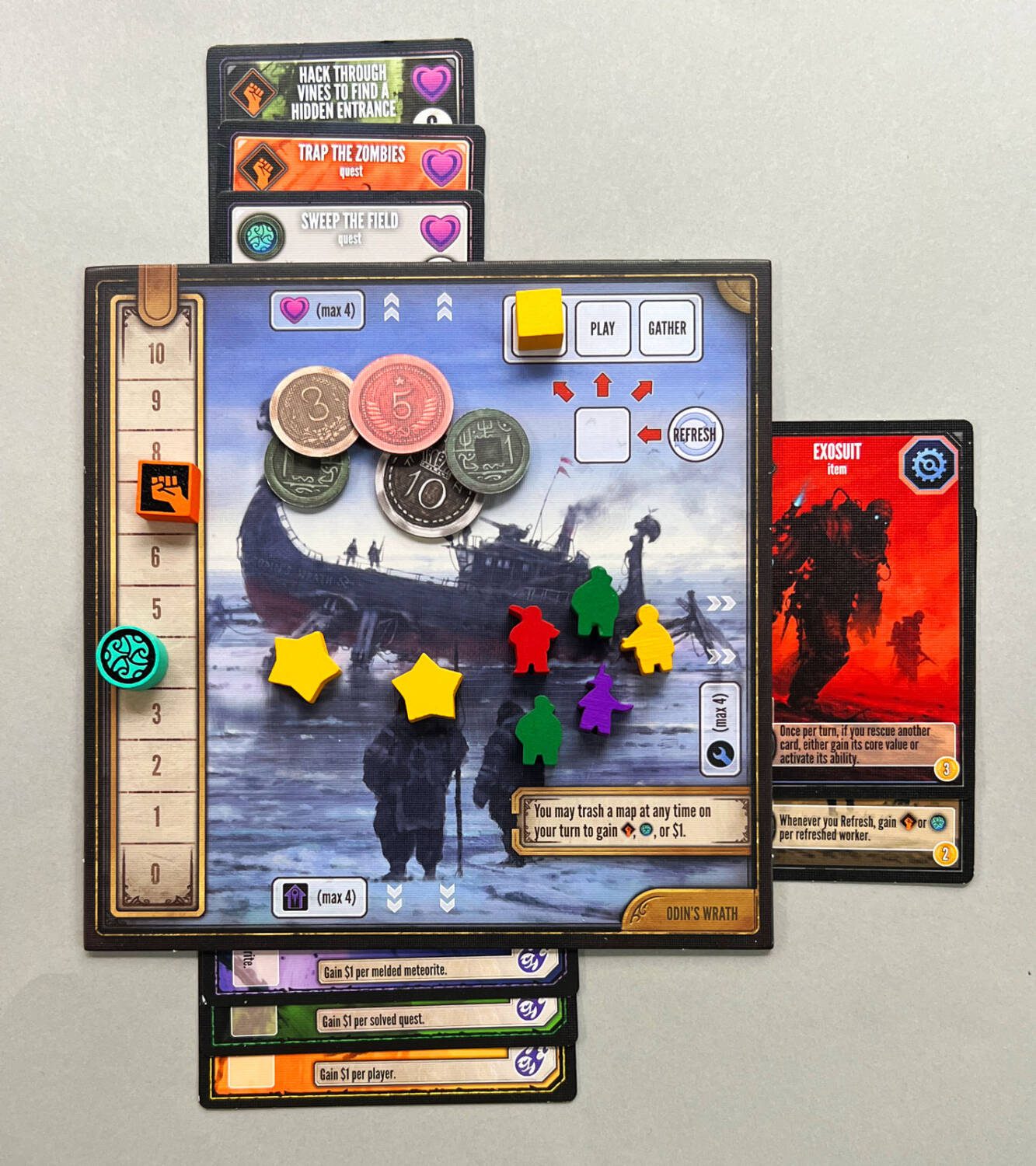
In our first play, we were feeling out the possibilities. At the end of that game, there was no question we’d be playing it again the following week. In that second game, we had a better understanding of how to score and when it was the most beneficial to do so. After that second game, someone said, “We are playing this again next week, right?” We all nodded. There was no question that we wanted to explore Expeditions further.
The preview copy I received from my friend and Meeple Mountain colleague, Justin Bell, was the Ironclad Edition. This version comes with die-cast metal Mechs that have a substantial heft to them. Like the poker-style gem chips in Splendor, the weight simply makes the game feel better to me.
The other components are just as good. Thick cardboard all around, with small, raised dots added to raise your player board up off the table enough to allow cards to slide under easily. The hexes are large, making Expeditions something of a table hog, but, for me, that’s the only nitpicky strike against the game.
The 90 cards that make up the standard deck, along with the 12 character & companion cards, expand upon Rozalski’s vision of the world of Scythe. I still find myself just going through the deck to look at his artwork.
Another unfortunate expectation that comes with calling this “A Sequel to Scythe” is that it begs the question, “Is Expeditions better than Scythe?” It’s an apples and oranges question: they are each very different games and there’s no way to judge one against the other. I like them both for different reasons. And I’m happy to play either one if asked.
That being said, one of my weekly gaming players said, halfway through our first game, that he liked Expeditions better than Scythe on the strength of the player interaction. That’s a valid point. As well, Expeditions can be somewhat more forgiving—I’ve lost Scythe games by making one crucial mistake late in the game. End games in Expeditions have largely been races to complete that fourth star and get to a Boast action (with that action available!) a move or two before the other players.
However, I have two minor issues with Expeditions. First, the game is table hog. You’ll need a big table to set out all the tiles, as well as your player boards. Second, the Map tokens are the same as the Encounter tokens from Scythe. Claiming one in Expeditions just gets you…the Map token. If you’re coming from Scythe, this is very unfulfilling.
Those minor issues aside, I like Expeditions. A lot.
I’ve played with my gaming group for many years now. This is the first time when I’ve said, “I have another game for review to play next week,” that it has been met with, “Can’t we play this for a few more weeks?”
So guess what we’re doing? That’s how good Expeditions is.
(Jamey Stegmaier has already announced an expansion for Expeditions later in 2024. It’s already on my Must Have list.)


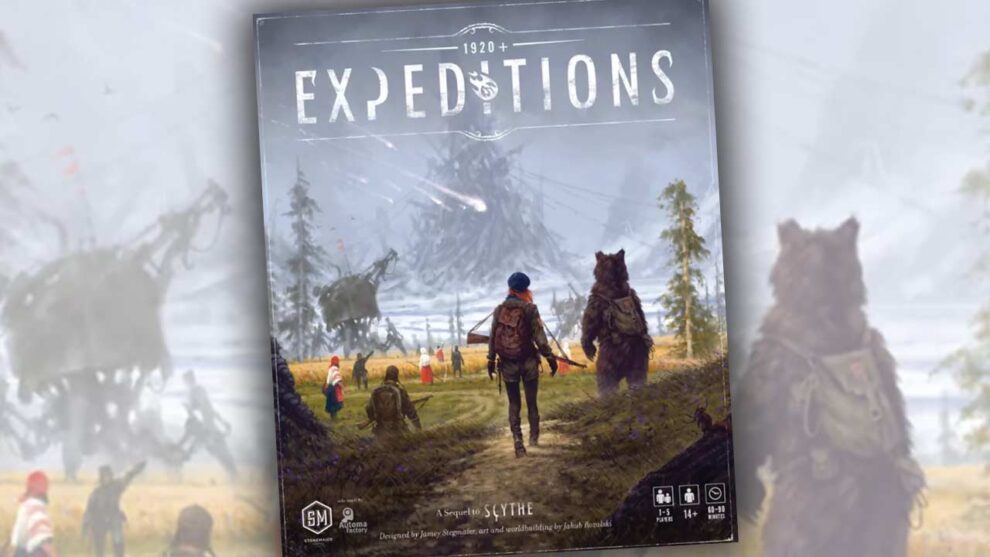



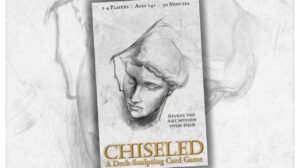





Thank you for sharing this thoughtful review. I especially liked your comment regarding how the management of expectations for this game could have been done differently, and “A Game in the World of Scythe” seems like a much better descriptor for this entry in the Stonemaier catalog.
I like Scythe very much and I enjoyed Expeditions. However, I feel that base-game Scythe is fulfilling without any of its expansions (although the expansions for it certainly enhance the strategic depth and player agency in a positive way). Whereas Scythe doesn’t need an expansion to be very good, Expeditions seems incomplete without one, and I hope that the surprisingly superficial exploration mechanic is addressed with future content.
I just wish there was more game to support the fantastic art and production values.
Thanks for the comment, Thomas. I love to read the thoughts from our readers.
I’ve played Scythe in person about 20 times (if my BGG stats are correct) and at least 3x that number online. I have the Invaders from Afar expansion on Steam and I recommend it. The two new factions play very differently from the base game’s factions and can be challenging to play, especially at first.
My weekly gaming group and I continue to enjoy Expeditions. For me, Expeditions is a solid game that wouldn’t feel lacking in any way if it weren’t for the expectations that come along with some of the Scythe.
What would you add to the Exploration mechanic?
I’d like to see the Encounter/Map tokens be worth money at the end of the game (maybe half a coin each?) rather than just having five of them be a Goal and nothing more.
Exploration is required to find the Meld, Upgrade, and Boast abilities. However, in our last game, we left four or five tiles unexplored. Maybe the game couldn’t end until all tiles were explored? And one or two of the tiles could have a negative impact when explored (costing money or Corruption)?
I’m glad you liked the, “A Game in the World of Scythe” idea. I liked it, too.
— Tom